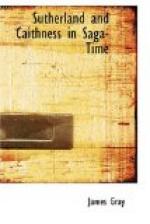No stately church like the Cathedral of St. Magnus at Kirkwall, itself the finest specimen of Norman architecture in Scotland, survives on the mainland from Viking days; nor, so far as is known, was any such edifice built there by any Norseman; but the original High Church of Halkirk, and also the old church of St. Bar at Dornoch, which preceded and is believed to have occupied a site immediately to the east of St. Gilbert’s later Cathedral, may have been used by the later jarls, and a few miles south of Halkirk are the foundations of the Spittal of St. Magnus,[12] part of which, and of St. Peter’s Church at Thurso may be Norse.
Though the towns of Wick and Thurso[13] are frequently mentioned in the Orkneyinga Saga, and earls and jarls stayed at both, no Sutherland village (if any save Dornoch existed) is named in it; but the site of modern Golspie (Gol’s-by) appears in ancient charters as Platagall, “the Flat of the Stranger."[14]
If in his outward and visible man the Norseman has all but faded away in Sutherland, he remains more in evidence in Caithness, in spite of Celtic mothers and successive waves of Scottish immigration. The high Norse skull, the tall frame with broad shoulders and narrow hips,[15] the fair hair and skin, the sea-blue eyes and sound teeth are still to be seen; and from time to time, amid greatly preponderating Celtic types, we are startled by coming across some perfect living specimen of the pure Viking type almost always on or near the coast.
But, if the outward type is rarely seen, its inward qualities remain. What were those qualities?
The late Professor York Powell summed up the character of the Viking emigrant folk in his introduction to Mr. Collingwood’s Scandinavian Britain, as follows:—
“A sturdy, thrifty, hardworking, law-loving people, fond of good cheer and strong drink, of shrewd, blunt speech, and a stubborn reticence, when speech would be useless or foolish; a people clean-living, faithful to friend and kinsman, truthful, hospitable, liking to make a fair show, but not vain or boastful; a people with perhaps little play of fancy or great range of thought, but cool-thinking, resolute, determined, able to realise the plainer facts of life clearly, and even deeply."[16]
Blend these qualities with those of the Gael, and what infinite possibilities appear; for the characteristics of the two races supplement each other. Fuse them together in proper proportions for a few generations, the improvident and dreamy with the thrifty and energetic, the voluble with the reticent, the romantic and humorous with the truthful and blunt of speech, the fiery and impulsive with the sober of thought, and how greatly is the type improved in the new race evolved from the union of both.




